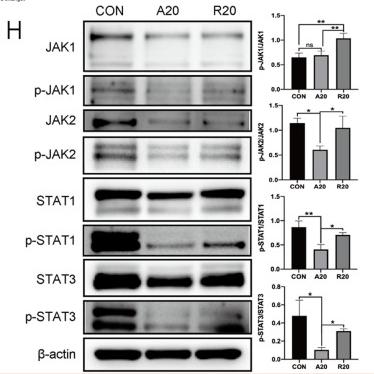IKB epsilon Antibody - #AF6002
| Product: | IKB epsilon Antibody |
| Catalog: | AF6002 |
| Description: | Rabbit polyclonal antibody to IKB epsilon |
| Application: | WB IHC IF/ICC |
| Reactivity: | Human, Mouse, Rat |
| Prediction: | Pig, Bovine, Horse, Sheep, Rabbit, Dog, Chicken |
| Mol.Wt.: | 45kDa; 53kD(Calculated). |
| Uniprot: | O00221 |
| RRID: | AB_2834937 |
Product Info
*The optimal dilutions should be determined by the end user.
*Tips:
WB: For western blot detection of denatured protein samples. IHC: For immunohistochemical detection of paraffin sections (IHC-p) or frozen sections (IHC-f) of tissue samples. IF/ICC: For immunofluorescence detection of cell samples. ELISA(peptide): For ELISA detection of antigenic peptide.
Cite Format: Affinity Biosciences Cat# AF6002, RRID:AB_2834937.
Fold/Unfold
I kappa B epsilon; I-kappa-B-epsilon; IkappaBepsilon; IkB E; IkB-E; IkB-epsilon; IKBE; IKBE_HUMAN; MGC72568; NF kappa B inhibitor epsilon; NF kappa BIE; NF-kappa-B inhibitor epsilon; NF-kappa-BIE; NFkappa BIE; NFkappaB inhibitor epsilon; NFKBIE; Nuclear factor of kappa light polypeptide gene enhancer in B cells inhibitor epsilon; OTTHUMP00000016522; Slc35b2; solute carrier family 35, member B2;
Immunogens
Highly expressed in spleen, testis and lung, followed by kidney, pancreas, heart, placenta and brain. Also expressed in granulocytes and macrophages.
- O00221 IKBE_HUMAN:
- Protein BLAST With
- NCBI/
- ExPASy/
- Uniprot
MNQRRSESRPGNHRLQAYAEPGKGDSGGAGPLSGSARRGRGGGGAIRVRRPCWSGGAGRGGGPAWAVRLPTVTAGWTWPALRTLSSLRAGPSEPHSPGRRPPRAGRPLCQADPQPGKAARRSLEPDPAQTGPRPARAAGMSEARKGPDEAEESQYDSGIESLRSLRSLPESTSAPASGPSDGSPQPCTHPPGPVKEPQEKEDADGERADSTYGSSSLTYTLSLLGGPEAEDPAPRLPLPHVGALSPQQLEALTYISEDGDTLVHLAVIHEAPAVLLCCLALLPQEVLDIQNNLYQTALHLAVHLDQPGAVRALVLKGASRALQDRHGDTALHVACQRQHLACARCLLEGRPEPGRGTSHSLDLQLQNWQGLACLHIATLQKNQPLMELLLRNGADIDVQEGTSGKTALHLAVETQERGLVQFLLQAGAQVDARMLNGCTPLHLAAGRGLMGISSTLCKAGADSLLRNVEDETPQDLTEESLVLLPFDDLKISGKLLLCTD
Predictions
Score>80(red) has high confidence and is suggested to be used for WB detection. *The prediction model is mainly based on the alignment of immunogen sequences, the results are for reference only, not as the basis of quality assurance.
High(score>80) Medium(80>score>50) Low(score<50) No confidence
PTMs - O00221 As Substrate
| Site | PTM Type | Enzyme | Source |
|---|---|---|---|
| S54 | Phosphorylation | Uniprot | |
| S86 | Phosphorylation | Uniprot | |
| S153 | Phosphorylation | Uniprot | |
| Y155 | Phosphorylation | Uniprot | |
| S157 | Phosphorylation | Uniprot | |
| S161 | Phosphorylation | Uniprot | |
| S164 | Phosphorylation | Uniprot | |
| S167 | Phosphorylation | Uniprot | |
| S177 | Phosphorylation | Uniprot | |
| S183 | Phosphorylation | Uniprot | |
| K316 | Ubiquitination | Uniprot |
Research Backgrounds
Inhibits NF-kappa-B by complexing with and trapping it in the cytoplasm. Inhibits DNA-binding of NF-kappa-B p50-p65 and p50-c-Rel complexes.
Serine phosphorylated; followed by proteasome-dependent degradation.
Cytoplasm.
Highly expressed in spleen, testis and lung, followed by kidney, pancreas, heart, placenta and brain. Also expressed in granulocytes and macrophages.
Interacts with RELA, REL, NFKB1 nuclear factor NF-kappa-B p50 subunit and NFKB2 nuclear factor NF-kappa-B p52 subunit.
Belongs to the NF-kappa-B inhibitor family.
Research Fields
· Human Diseases > Infectious diseases: Viral > Epstein-Barr virus infection.
· Organismal Systems > Immune system > Th1 and Th2 cell differentiation. (View pathway)
· Organismal Systems > Immune system > Th17 cell differentiation. (View pathway)
· Organismal Systems > Immune system > T cell receptor signaling pathway. (View pathway)
· Organismal Systems > Immune system > B cell receptor signaling pathway. (View pathway)
· Organismal Systems > Nervous system > Neurotrophin signaling pathway. (View pathway)
· Organismal Systems > Endocrine system > Adipocytokine signaling pathway.
References
Application: WB Species: Mice Sample:
Restrictive clause
Affinity Biosciences tests all products strictly. Citations are provided as a resource for additional applications that have not been validated by Affinity Biosciences. Please choose the appropriate format for each application and consult Materials and Methods sections for additional details about the use of any product in these publications.
For Research Use Only.
Not for use in diagnostic or therapeutic procedures. Not for resale. Not for distribution without written consent. Affinity Biosciences will not be held responsible for patent infringement or other violations that may occur with the use of our products. Affinity Biosciences, Affinity Biosciences Logo and all other trademarks are the property of Affinity Biosciences LTD.

